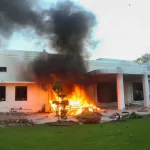By Agha Iqrar Haroon
Dealing with international media and receiving news that a minority faith place is attacked and almost burnt down in your country put you in an embarrassing situation if asked about such incidents by your colleagues or friends.
I can tell my colleagues that it was the work of a handful of miscreants and the government has arrested them in the case related to the attack on the Hindu temple in Rahim Yar Khan but they (colleagues) can ask me that why did your local administration take action after Chief Justice of your country expressed his serious concern over the incident. This was the second incident of attacking Hindu Temple this year as the first was in Rawalpindi in March 2021.
The question is valid why did civil administration and Police not arrest culprits well before Chief Justice asked them for a report although their faces were clear in several footages that appeared on social media?
Attacking and burning a faith place of a minority sends exceptional adverse messages at global level and Pakistan is trying hard to show its soft image is a victim of such miscreants and such state of mind earlier also and then our counter-terrorism investigation found that several of persons who attacked faith places of minorities were working for enemies of Pakistan. This is a long debate how did Pakistan became a victim of radicalism and by whom and what for? But is a fact that Pakistan has already paid a huge cost of this economically and socially and sacrificed over 70,000 innocent civilians and thousands of sons in uniforms. Is it not enough?
Instead of getting into a stereotype of administrative actions and releasing statements for face-saving, this is time administrative tools of the country must submit cases against culprits so courts would get meat to announce exemplary punishments for them because such people are not only dangerous for minorities rather for the image of the country as well. They ruin diplomatic initiatives of the State and indirectly become tools for our enemies who always portray Pakistan as an unlivable country for minorities.
The studies of Human development indicate that flourishing societies are usually multiethnic and cross-religious.
We have classical examples of exceptionally flourishing states like the Ottoman Empire and Mughal Era in past and in the modern world, UAE, United States, Canada, today’s Central Asian states, Malaysia, and several European countries. There is a saying in the Urdu language that a single flower does not make a garden, nor does a single bird bring spring.
The relationship between minority cultures and globalization presented by Makere Stewart-Harawira in her book “The New Imperial Order” indicates that the diversification of viewpoints is key to human development in today’s global context of economic, political, and cultural systematization.
Interfaith harmony fights negative powers in societies. Islam promotes interfaith harmony and the Father Nation Muhammad Ali Jinnah in his first speech after Pakistan came into being said that everybody would be free to go to his faith place. He always promoted that Pakistan and Islam had (have) nothing to do with radicalization and extremism.
Professor Furqan Makassar of Universitas Islam Negeri, Indonesia in one of his academic papers says that a person who endeavors to understand his religion without caring to understand the community can be radical. A Muslim sociologist, Professor Tahir Kasnawi stated, the effort and spirit to understand society without understanding religion correctly and will result in making someone liberal. In contrast, the lack of understanding of religion and culture leads someone to become a terrorist (Kasnawi, 2015). He further said that no matter how high religious teaching (Islam) exists, what exists in human life and influences society is its concrete implementation in history, namely humans’ social and cultural life in space and time.
By conducting a thematic interpretation study with an anthropological approach, the concept of interpretation is found, which produces an inclusive understanding with tolerance and harmony in diversity. There are many Qur’anic verses that show that diversity is God’s will as a test for humans to compete in goodness. Humans must realize tolerance, harmony, and cooperation, so it is necessary to form a collective agreement jointly. Therefore, cross-faith and cultural dialogue must be carried out continuously by promoting ethics.
An academic paper “The Dialogue of Multicultural Education and Harmony in Prosperity Based on the Qur’an” says:
The first step undertaken by the Prophet in Medina with his friends after arriving in Medina was to build a mosque as a center for the development of the ummah. The next step is to collaborate with all components of the Medina community to build a city-state. The result was the creation of the Medina Charter.
The Medina Charter provided a basis for a city-state between the Muslims and the Jews in the medieval Muslim city of Medina. It is considered the first written constitution in Islam and the first documented case of constitutional law. It is also a historical example of conflict resolution in Islam. The methods of conflict resolution in the Medina Charter in comparison with the modern ideas of Western conflict resolution theory—mediation, fractioning, and focusing on goals and interests as opposed to individual religion, and power-balancing. Ottoman Empire always used this document for Conflict Resolution.
Is it not time that we promote Medina Charter in our society and put it in our school books to create a tolerant society that we have almost lost in the last 40 years?
The views and opinions expressed in this article/Opinion/Comment are those of the author and do not necessarily reflect the official policy or position of the DND Thought Center and Dispatch News Desk (DND). Assumptions made within the analysis are not reflective of the position of the DND Thought Center and Dispatch News Desk News Agency.




